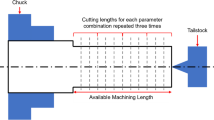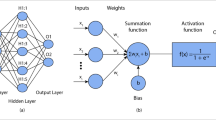Abstract
In recent years, there has been a growing interest for the prediction of machining characteristics (such as surface roughness and tool wear) during machining. Several machining parameters such as cutting speed and cutting depth are known to affect the surface characteristics. Various methods are used to investigate the relative contribution of these parameters on the surface characteristics. Therefore, selecting a set of parameters according to the relative contributions is important in the prediction of the surface characteristics effectively. In this paper, a new alternative parameter selection method based on artificial neural networks is suggested. Within this scope, forward and stepwise selection methods are proposed. A statistical hypothesis test is used as an elimination criterion. The suggested methods are used to predict the surface roughness in turning operations effectively. Successful results were obtained in the prediction of surface roughness by using these methods.
Similar content being viewed by others
Abbreviations
- K :
-
Tool stiffness coefficient (N/m)
- CD:
-
Cutting depth (mm)
- OL:
-
Tool overhang length (mm)
- S :
-
Tool damping ratio (%)
- SRA:
-
Side rake angle (\(^{\circ }\))
- ECA:
-
End cutting angle (\(^{\circ }\))
- NR:
-
The number of revolutions per minute (rpm)
- WD:
-
Workpiece diameter (mm)
- BRA:
-
Back rake angle (\(^{\circ }\))
- IH:
-
Insert hardness (HV)
- SCA:
-
Side clearance angle (\(^{\circ }\))
- AA:
-
Approach angle (\(^{\circ }\))
- WH:
-
Workpiece hardness (HV)
References
Davim, J.P.: Surface Integrity in Machining. Springer Science & Business Media, Berlin (2010)
Abuelnaga, A.M.; El-Dardiry, M.A.: Optimization methods for metal cutting. Int. J. Mach. Tool Des. Res. 24(1), 11–18 (1984)
Aggarwal, A.; Singh, H.: Optmization of machining technique—a retrospective and literature review. Sadhand 30(6), 699–711 (2005)
Mukherjee, I.; Ray, P.K.: A review of optimization techniques in metal cutting processes. Comput. Ind. Eng. 50(1), 15–34 (2006)
Kurdi, M.H.; Schmitz, T.L.; Haftka, R.T.; Mann, B.P.: Simultaneous optimization of material removal rate and part accuracy in high speed milling. In: ASME International Mechanical Engineering Congress and Exposition (IMECE), pp. 1001–1009 (2004)
Kurdi, M.H.: Robust multicriteria optimization of surface location error and material removal rate in high speed milling under uncertainty. Department of Mechanical and Aerospace Engineering, University of Florida (2005)
Krishna, A.: Selection of optimal conditions in the surface grinding process using a differential evolution approach. Proc. Inst. Mech. Eng. Part B J. Eng. Manuf. 221(7), 1185–1192 (2007)
Saikumar, S.; Shunmugan, M.S.: Parameter selection based on surface finish in high speed finish in high speed end milling using differential evolution. Mater. Manuf. Process. 21(4), 341–347 (2008)
Walvekar, A.G.; Lambert, B.K.: An application of geometric programming to machining variable selection. Int. J. Prod. Res. 8(3), 241–245 (1970)
Sonmez, A.I.; Baykasoglu, A.; Dereli, T.; Filiz, I.H.: Dynamic optimization of multipass milling operations via geometric programming. Int. J. Mach. Tools Manuf. 39(2), 297–320 (1999)
Abburi, N.; Dixit, U.: Multi-objective optimization of multipass turning processes. Int. J. Adv. Manuf. Technol. 32(9), 902–910 (2007)
Lin, T.R.: Optimisation technique for face milling stainless steel with multiple performance characteristics. Int. J. Adv. Manuf. Technol. 19(5), 330–335 (2002)
Bajic, D.; Lela, B.; Zivkovic, D.: Modeling of machined surface roughness and optimization of cutting parameters in face milling. Metalurgija 47(4), 331–334 (2008)
Subramanian, M.; Sakthivel, M.; Sooryaprakash, K.; Sudhakaran, R.: Optimization of end mill tool geometry parameters for Al7075-T6 machining operations based on vibration amplitude by response surface methodology. Measurement 46(10), 4005–4022 (2013)
Venkatesan, K.; Ramanujam, R.; Joel, J.; Jeyapandiarajan, P.; Vignesh, M.; Tolia, D.J.; Krishna, R.V.: Study of cutting force and surface roughness in machining of Al alloy hybrid composite and optimized using response surface methodology. Proc. Eng. 97, 677–686 (2014)
Ramesh, S.; Karunamoorthy, L.; Palanikumar, K.: Surface roughness analysis in machining of titanium alloy. Mater. Manuf. Process. 23, 174–181 (2008)
Ramesh, S.; Karunamoorthy, L.; Palanikumar, K.: Measurement and analysis of surface roughness in turning of aerospace titanium alloy (Gr5). Measurement 45, 1266–1276 (2012)
Rajmohan, T.; Palanikumar, K.: Application of the central composite design in optimization of machining parameters in drilling hybrid metal matrix composites. Measurement 46, 1470–1481 (2013)
Budak, E.: Improving productivity and part quality in milling of titanium based impellers by chatter suppression and force control. CIRP Ann. Manuf. Technol. 49(1), 31–36 (2000)
El-Mounayri, H.; Kishawy, H.; Briceno, J.: Optimization of CNC ball end milling: a neural network-based model. J. Mater. Process. Technol. 166(1), 50–62 (2005)
Juan, H.; Yu, S.F.; Lee, B.Y.: The optimal cutting-parameter selection of production cost in HSM for SKD61 tool steels. Int. J. Mach. Tools Manuf. 43(7), 679–686 (2003)
Wang, Z.G.; Rahman, M.; Wong, Y.S.; Sun, J.: Optimization of multi-pass milling using parallel genetic algorithm and parallel genetic simulated annealing. Int. J. Mach. Tools Manuf. 45(15), 1726–1734 (2005)
Yajun, J.; Zhenliang, L.; Minghui, L.: Application of fuzzy and rough sets theory in the optimization of machining parameters for mold milling operations. Int. J. Adv. Manuf. Technol. 28(11), 1071–1077 (2006)
Parent, L.; Songmene, V.; Kenne, J.P.: A generalised model for optimising and end milling operation. Prod. Plan. Control 18(4), 319–337 (2007)
Savas, V.; Ozay, C.: The optimization of the surface roughness in the process of tangential turn-milling using genetic algorithm. Int. J. Adv. Manuf. Technol. 37(3–4), 335–340 (2007)
Mahdavinejad, R.A.; Khani, N.; Fakhrabadi, M.M.S.: Optimization of milling parameters using artificial neural network and artificial immune system. J. Mech. Sci. Technol. 26, 4097–4104 (2012)
Davim, J.P.: Design of optimisation of cutting parameters for turning metal matrix composites based on the orthogonal arrays. J. Mater. Process. Technol. 132, 340–344 (2003)
Al Hazza, M.H.F.; Adesta, E.Y.T.; Hasan, M.H.; Shaffiar, N.: Surface roughness modeling in high speed hard turning using regression analysis. Int. Rev. Mech. Eng. 8, 431–436 (2014)
Gaitonde, V.N.; Karnik, S.; Figueira, L.; Davim, J.P.: Performance comparison of conventional and wiper ceramic inserts in hard turning through artificial neural network modeling. Int. J. Adv. Manuf. Technol. 52, 101–114 (2011)
Kumar, R.; Chauhan, S.: Study on surface roughness measurement for turning of Al 7075/10/SiCp and Al 7075 hybrid composites by using response surface methodology (RSM) and artificial neural networking (ANN). Measurement 65, 166–180 (2015)
Sahoo, A.; Rout, A.; Das, D.: Response surface and artificial neural network prediction model and optimization for surface roughness in machining. Int. J. Ind. Eng. Comput. 6, 229–240 (2015)
Acayaba, G.M.A.; de Escalona, P.M.: Prediction of surface roughness in low speed turning of AISI316 austenitic stainless steel. CIRP J. Manuf. Sci. Technol. 11, 62–67 (2015)
Karabulut, S.: Optimization of surface roughness and cutting force during AA7039/Al2O3 metal matrix composites milling using neural networks and Taguchi method. Measurement 66, 139–149 (2015)
Yegnanarayana, B.: Artificial Neural Networks. PHI Learning Pvt. Ltd, New Delhi (2009)
Rosenthal, G.; Rosenthal, J.A.: Statistics and Data Interpretation for Social Work. Springer, Berlin (2011)
Antony, J.: Design of Experiments for Engineers and Scientists. Elsevier, Amsterdam (2014)
Author information
Authors and Affiliations
Corresponding author
Rights and permissions
About this article
Cite this article
Arapoğlu, R.A., Sofuoğlu, M.A. & Orak, S. An ANN-Based Method to Predict Surface Roughness in Turning Operations. Arab J Sci Eng 42, 1929–1940 (2017). https://doi.org/10.1007/s13369-016-2385-y
Received:
Accepted:
Published:
Issue Date:
DOI: https://doi.org/10.1007/s13369-016-2385-y




